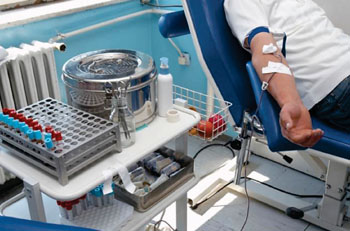Medical Center Saves Money by Reducing Blood Wastage
By LabMedica International staff writers
Posted on 04 Aug 2016
Blood transfusions raise the risk of transfusion reaction, infection, longer hospital stays, and even death, and there is evidence that a restrictive transfusion strategy, as opposed to a liberal one, results in better outcomes for patients.Posted on 04 Aug 2016
By implementing institution-wide initiatives around blood management, an academic medical center reports saving millions of dollars and dramatically reducing blood wastage. The first part of the blood management system the team addressed was the ordering process. They changed provider orders from the standard practice of ordering two units, to one of ordering one unit then following up with a further order if needed.

Image: Blood being donated for transfusion (Photo courtesy of Vanderbilt University Medical Center).
Scientists at Vanderbilt University Medical Center (Nashville, TN, USA) noted that many hospitals commonly order a transfusion based on habit rather than individual assessment. By changing their blood ordering practices to be more specific, they reduced usage of red blood cells for transfusions by more than 30%, from 675 units per 1,000 discharges in 2011 down to 432 units per 1,000 discharges in 2015. The team also looked at the blood patients received in the period surrounding their operation. Some of the patients are included in the hospital's National Surgical Quality Improvement Program (NSQIP) system.
The team found that data collected on general and vascular surgery patients who underwent NSQIP-targeted procedures showed a reduction from 11% transfused with an average of 4.6 units of blood per patient in 2011, to 5-6 %t transfused with an average of 2.4 units per patient in 2015. The patients had undergone procedures that included colectomy, proctectomy, ventral hernia, and appendectomy. As well as looking at blood usage, the team also implemented measures to reduce blood wastage across the whole system. These included specific changes, for example: when ordering more than one unit of blood, have it sent in a cooler rather than a pneumatic tube; reconfigure coolers to ensure blood transported at optimum temperature; have blood products "owned" by specific members of staff – these "owners" responsible for returning unused product to the blood bank; and ensure clinical leaders review individual blood unit wastage and collect overall data and report it monthly.
Barbara J. Martin, MBA, RN, the lead author of the study said, “We were looking at whether we could guide providers to treat symptomatic anemia with a single unit of blood rather than the usual two units. We were able to change the mindset of the entire institution, initially, and then determine that the improved usage with decreased wastage was beneficial to patient outcomes is a huge success for the team, the institution, and most importantly, the patients.” The study was presented at the American College of Surgeons National Surgical Quality Improvement Program (ACS NSQIP) Conference held July 16-19, 2016, San Diego, CA; USA.
Related Links:
Vanderbilt University Medical Center




 assay.jpg)









